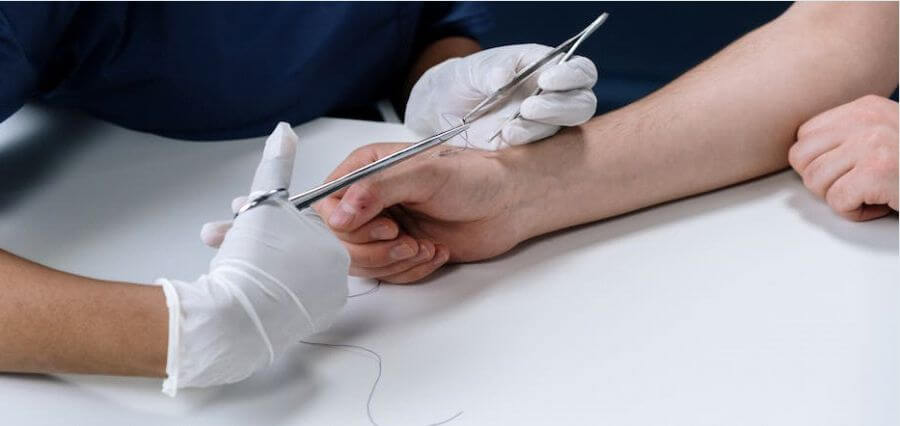When dealing with first aid, knowing how to patch a wound is only part of the equation. The right types of stitches play a huge role in how soon a wound can heal and stay closed.
Keep reading to learn more about the best stitches for wounds, their uses, and how they can help with medical first aid and healing. We can help you easily treat open wounds.
Let’s get you started!
Interrupted Sutures
Interrupted sutures are used when it is important to bring the wound edges closer together and provide support for the wound. These sutures are placed as individual stitches and consist of a single suture placed each time. Interrupted sutures can be placed rapidly, and the tension of each stitch can be controlled.
They also cause less tissue trauma than continuous sutures. The tightly-tied knots in interrupted sutures help to minimize tissue trauma and make wound closure generally easier. Indications for interrupted sutures are incisions that require strong closure, such as the scalp and face, or where there is a need to provide an equal amount of tension across the wound edges.
Special wound care must be taken to be sure that the knots are tied securely. Interrupted sutures are used in the following ways:
- traumatic wounds
- reconstructive surgeries
- placing more delicate sutures
These sutures are most commonly used in conjunction with other types of sutures for extra support.
Continuous Sutures
Continuous sutures are a type of stitch used to close wounds. They are used to help keep a wound tightly closed and to improve the chances of successful wound healing. Continuous sutures involve passing the needle continually through the skin around the wound’s edges.
After passing through the skin, the needle is knotted, and the stitch is continuous. They are usually applied using absorbable threads, which break down and are absorbed into the body. This type of stitching is useful for closing deep wounds and controlling lymphatic leakage from delicate tissues.
It is also effective for a wound that is inverting or where the edges of the skin are hard to align. Continuous sutures are a great way of minimizing tissue damage and accelerating healing.
Vertical Mattress Sutures
A vertical mattress suture is one type of stitch used to close wounds. This stitch helps to reduce tension on the wound edges and increases tensile strength. This type of stitch is created by making a series of two bites on the edges of the wound and connecting them with a continuous loop of suture material.
Each bite is placed at a 90-degree angle, perpendicular to the wound’s edges. This method helps to keep the edges of the wound evenly together. The vertical mattress suture is ideal for closing deep wounds and for use in areas with fragile skin, such as the face.
It is also often used to hold a skin graft. However, this type of stitch often puts more of a strain on the tissue and can be more difficult to remove compared to other types of stitches.
Horizontal Mattress Sutures
Horizontal mattress sutures are used for closing deeper wounds due to their strong, secure closure. They are made from a continuous strand of absorbable or non-absorbable suture material and run in and out of the wound in a mattress-like fashion, crossing the wound bed twice. This creates a strong bond that helps to pull the wound edges together while allowing for tissue expansion as the wound heals.
Additionally, these sutures are useful in creating a more aesthetic closure, keeping the wound edges in apposition and offering bulkier support, making them ideal for larger, more difficult-to-close wounds. Unlike buried sutures, horizontal mattress sutures are left in place under the skin, although they will eventually dissolve, eventually minimizing any scarring.
Running Sutures
Running sutures are one of the different types of sutures for wounds. These stitches are commonly used for closures on lacerations, as well as other wounds on the surface of the skin. The technique involves inserting a needle that’s attached to a long monofilament through the edges of the wound.
The suture is then pulled through the skin, with each pass forming a single stitch. Running sutures reduce the time needed to suture a wound and may also reduce trauma during the closure. They increase the strength of the closure and provide increased wound eversion, or turning outward of the wound edges.
Running sutures should be used with caution, however, as they are more likely to tear through tissue and cause more trauma to the wound than simple interrupted sutures.
Sub-cuticular Sutures
Subcuticular sutures are one of the various types of medical sutures used to close wounds. This type of suture, also known as a subcuticular stitch, provides a watertight closure of the wound. The suture is applied to the tissue just below the skin surface and is used for large lacerations, full-thickness skin wounds, and reconstructive flap closures.
Advantages of subcuticular sutures include reduced suture removal times, decreased risk of infection, and improved cosmetic results. The technique requires specialized suturing equipment and may be difficult for some new medical providers and veterinary technicians to master. The success of wound closure is largely reliant on proper suturing techniques.
Simple Interrupted Locking Sutures
Simple interrupted locking sutures are used frequently in wound care. They are used to close an incision by forming a small, evenly-spaced stitch. A simple interrupted locking suture is a single stitch placed by passing a loop of suture thread through the wound, with each end of the thread looped around a needle.
After each stitch is placed, the needle is pulled tight, and the thread is tied off. This type of suture provides a strong, secure closure with minimal tension on the wound edges. They are also easy to remove and require minimal tissue trauma, as no knots need to be tied in the tissue.
Simple interrupted locking sutures are placed in crescent or figure-of-eight patterns to prevent gaping at the wound edges. They are ideal for use in areas of low tension and where there is only minimal or no tension on the wound edges.
If you want to learn these types of wound stitches, you may want to order suture practice kits here.
Learn Different Types of Stitches
Stitches are an important part of wound care. There are so many different types of stitches, each uniquely suited to different types of wounds. So, if you ever need to care for a wound, remember to always consult your health professional for the best stitch and treatment options.
For more helpful articles like this, visit our blog.
Read More: Click Here















